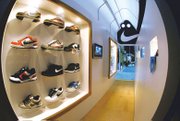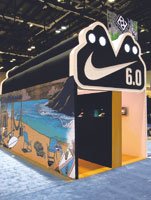Setting the Scene
Display Boys creates new retail and trade show environments.
Imaginative store design is an important ingredient in attracting shoppers to boutiques and emporiums. Similarly, creative booth design is crucial to catching the eye of frenzied buyers at busy trade shows. It’s the job of Santa Ana, Calif.–based Display Boys to make sure its designs for retail interiors and trade show booths have the right stuff to earn a second and third look from shoppers and jaded buyers.
Display Boys has been in the business of building and designing retail environments and fixtures since 1989. With a client list that includes Pacific Sunwear, Nike and DC Shoes, this design business, with 29 employees, has been a leader in the creation of interiors that help sell a brand. Design Boys President and Chief Creative Officer Darin Rasmussen talked to California Apparel News Retail Editor Andrew Asch about using trade show booths and retail display to create a new brand experience, visual display’s green movement, and what makes an environment stand out from the crowd.
CAN: Is there still a lot more freedom in designing trade show booths compared with the design of stores?
DR: There is more freedom with design than ever. The public and the consumer are more savvy and demand a higher level of engagement and experience, especially at retail. The younger generation is expecting this in our new era of instant gratification. Technology is playing larger roles. Touch screens and interactivity and audio/video are being used more and more. It has become economically feasible now. In the past five years, [the price of] technology has dropped. For example, some LCD screens have dropped from $1,000 per screen to less than $150.
Here’s one way we used technology: In 2008, we won the In Store Marketing Institute’s “Design of the Times” award for a New Balance footwear fixture. It incorporated a motion-activated video to play once a shopper walked up to the display. A looping video in the fixture explained how the technology incorporated into the shoe.CAN: How are trade show environments and fixtures different from retail fixtures?
DR: It’s like inventing a new awesome cookie recipe and then baking one cookie versus baking thousands of cookies. Retail programs are developed for mass rollouts. Trade show exhibits are very complicated one-offs that demand intense structural design and engineering as well as customer support. The trade show booth stays alive, sometimes up to five to six years, constantly morphing throughout its life. Adding parts to a trade booth, removing parts, repairing, logistics, installation, dismantling and storage takes a truly dedicated [design company]. CAN: Design Boys has been offering environmentally friendly trade show booths. Is this a new trend?
DR: The use of eco materials has always been around. It’s just more mainstream and in the spotlight now. People are finally waking up a little. Sustainable woods and veneers are used mostly. Other materials like steel and aluminum are recyclable. There are really cool plastics like 3form, but they are very expensive. Cost is usually the deal killer when it comes to using these types of materials. People want to use them and talk about it but usually step away because of costs. As long as there is demand, it may get supplies up to where costs can come down to be affordable. We try to incorporate sustainable materials as much as possible as well as design with a “less is more” approach when it comes to structure and mass.CAN: Describe the way your company brainstorms ideas.
DR: It’s a very collaborative effort. We like to bring in the insight of the brand and the retailer so they can own it. We become a conduit of brand and retailer. It all starts with insights and marketing data from the brand or retailer. Basically, the brand wants to look a certain way, and the retailer has its own policies. So how do you blend those two, and how do you take it a step further? One of the main objectives is the physical functionality of a unit, and then we think about how much cool can we throw at it. CAN: In a challenging economic environment, how can retailers freshen up the look of their store without undergoing a full-scale renovation?
DR: Promote value on the essential needs. Make the store-aisle end caps the location for these value destinations. Demonstrate value and how to strategize your purchases.
I think in fashion you have to do more than just put up sale signs on racks. Make the sale seem not cheap, just a great deal. To me, the most effective upgrade you could do in store is train the sales staff to be more friendly and helpful than ever. They need to make the shoppers feel good about their selections and purchases. If the store needs an appearance upgrade, just focus on one section of the store that needs the most attention, maybe the checkout area. Possibly add one cool element that makes a new and unique statement. CAN: From a visual-display standpoint, how can retail interiors help attract and retain customers?
DR: First of all, it begins with selection of products, then [it’s about] merchandising the products in an attractive way. Today’s shopper is drawn toward a “better shopping experience” and not just low price, although this situation might be temporary. And the more comfortable the environment, the longer a shopper will stay in the store ... and the longer they stay, the more they buy.
A store needs to feel warm overall. Store lighting is the most important element to achieve a warm feel. The use of directional lighting, mood lighting and other effects that shift from one space to another creates interest, discovery and warmth.
The use of natural materials like wood finishes not only warms up the space but, used in the right way, will achieve a refined and high-end look. In a large retail space, changing the flooring from one space to another will also create the feeling of discovery because you are literally stepping into a different space. Using fixtures and displays that shoppers can relate to and admire will also achieve a comfortable feeling.CAN: How did you start the company? How did it grow?
DR: I identified a need for retail merchandising and display in the action-sports industry in the late ’80s. The Display Boys doors opened in 1989, and word of mouth grew our business to many more industries. Today we have sales offices in Chicago and Connecticut that help service the country and our accounts more efficiently. Our company has been successful by developing and building relationships and creating a high level of service, along with our innovative designs that our clients appreciate.























